STATE PROFILE
STATE PROFILE
Tamil Nadu is one of the 28 States of India. The State has 38 Districts. Its capital and largest city is Chennai. The State of Tamil Nadu is situated in the southern part of the country between north latitude 8° 5' and 13° 35' east longitude between 76° 15' and 80° 20' . The total area of the State is 1,30,058 sq.km making it the eleventh largest State in the country. Tamil Nadu is one of the important Coastal States having a coastline of 1076 km. Tamil Nadu lies in the southernmost part of the Indian subcontinent and is bordered by the union territory of Puducherry and the South Indian States of Kerala, Karnataka, and Andhra Pradesh. It is bounded by the Eastern Ghats on the north, by the Nilgiri Mountains, the Meghamalai Hills, and Kerala on the west, by the Bay of Bengal in the east, by the Gulf of Mannar and the Palk Strait on the southeast, and by the Indian Ocean on the south. The State shares a maritime border with the nation of Sri Lanka.
Tamil Nadu can be divided broadly into two natural divisions (a) the coastal plains and (b) the hilly western areas. The average temperature in the plains varies between a minimum of 21.6o C to a maximum of 31.8o C and in the hilly areas varies between a minimum of 9.4o C to a maximum of 22.8oC.
The north-western, western and southern parts are hilly and rich in vegetation, with the Western Ghats effectively blocking much of the rain bearing clouds of the south west monsoon from entering the State. The eastern parts are fertile coastal plains and the northern parts are a mix of hills and plains. The central and the south central regions are arid plains and receive less rainfall than the other regions. Since Tamil Nadu is heavily dependent on monsoon rains for recharging its water resources, monsoon failures lead to acute water scarcity and severe drought. The normal annual rainfall of the State is about 908 mm of which 48 percent is through the north east monsoon and 32 percent through the south west monsoon.
Tamil Nadu includes a wide range of biomes, extending east from the south Western Ghats, montane rain forests in the Western Ghats through the south Deccan plateau, dry deciduous forests and Deccan thorn scrub forests to tropical dry broadleaved forests and then to the beaches, estuaries, salt marshes, mangroves, and coral reefs of the Bay of Bengal.
The total population of Tamil Nadu as per Census, 2011 was 72.1 million which is 5.96 percent of India’s population. It is the seventh most densely populated State in India with a population density of 555 persons per sq.km, significantly higher than the Indian average of 382 persons per sq.km (Census of India, 2011). Tamil Nadu the most urbanized State in India, with a population of 35 million spread over about 11 percent of the total area of the State i.e. over an area of 13,755 sq.km. The sex ratio in 2011 is estimated to be 987 females per 1000 males, which is well above the national average in 2011.
The capital of the State constituting of the Chennai Metropolitan area extends over 1,189 sq.km and its population is estimated to be about 8.8 million now. It constitutes more than 25 percent of the Tamil Nadu State urban population and more than 12 percent of the Tamil Nadu State total population. The population of the metropolitan area will be about 1.26 crore by 2026. The decadal growth rate for the period 2001-2011 has been 15.6 percent, which has increased from 11.7 percent estimated for the period 1991-2000.























